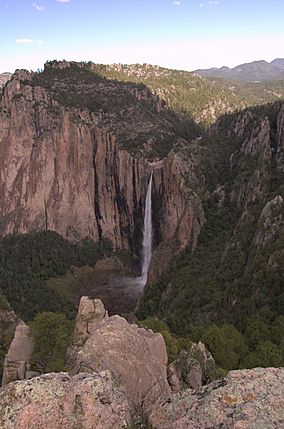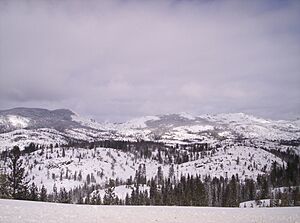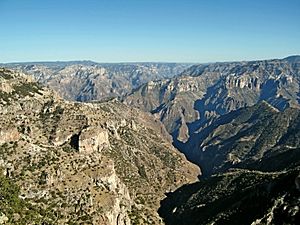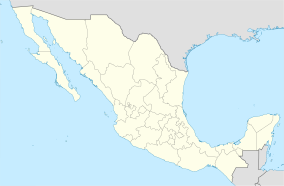Basaseachic Falls National Park facts for kids
Quick facts for kids Basaseachic Falls National Park |
|
|---|---|
|
IUCN Category II (National Park)
|
|
 |
|
| Location | Ocampo Municipality, Chihuahua, Mexico |
| Nearest city | Ocampo, Chihuahua |
| Area | 5,803 hectares (14,340 acres) |
| Established | February 2, 1981 |
| Governing body | Secretariat of the Environment and Natural Resources |
Basaseachic Falls National Park is a special place in the western part of Chihuahua, Mexico. It is found deep within the Sierra Madre Occidental mountains. The park gets its name from Basaseachic Falls, also known as Cascada de Basaseachic. This waterfall is the second tallest in Mexico! It drops an amazing 246 meters (853 ft).
The water from Basaseachic Falls flows into the huge Candameña Canyon. This canyon was carved out by the Basaseachic River over millions of years. The park is famous for its beautiful pine and oak forests. It also has amazing rock shapes and stunning views from very high cliffs. Some cliffs in the park reach a height of 1,640 meters (5,380 ft).
Contents
History of Basaseachic Falls
Europeans first found Basaseachic Falls around the 1700s. It quickly became a very popular spot for visitors in Chihuahua. Before the Spanish arrived, the area was home to the Tarahumara people. The name "Basaseachic" comes from their language, Rarámuri. It means "place of the waterfall."
The Mexican government created Basaseachic Falls National Park on February 2, 1981. President Jose Lopez Portillo made it official. The park covers 5,803 hectares (14,340 acres). It protects the area around the Basaseachic Falls and the amazing Candameña Canyon.
Geography and Canyons
The park is in a part of the Sierra Madre Occidental called Sierra Tarahumara. It is close to the town of Ocampo, Chihuahua. The land here is very dramatic. Huge movements of the Earth's plates caused big cracks and tall mountains. This powerful movement created the deep canyons and high peaks you see today. Over thousands of years, wind and the Basaseachic River have also shaped the land.
The walls of the Candameña Canyon are very steep and tall. They can reach a height of 1,640 meters (5,380 ft). Candameña Canyon is one of the deepest canyons in the Sierra Tarahumara. Two main rivers flow through the park: the Duraznos River and the Basaseachic River. Both rivers feed into Basaseachic Falls, which then empties into the Candameña Canyon. The water finally joins the Candameña River.
Climate and Weather


The weather in the park changes a lot depending on how high up you are. This means the park has many different small climates.
- Lower areas (below 700 meters): These spots are semi-arid. They are usually warm, with temperatures often reaching 39 °C (103 °F) in summer. They have a wet season in late summer and fall.
- Middle elevations (700-1,700 meters): These areas have a humid subtropical climate. Summers are warm and humid, often around 29 °C (84 °F). Winters are mild and usually dry. Most rain comes in late summer and fall.
- Higher elevations (1,700-2,800 meters): Here, the climate is humid continental. Summers are warm, but winters are cold. Temperatures can drop to -16 °C (3 °F). Rainstorms and snowstorms are common from November to March.
- Very high peaks (over 2,800 meters): These are the coldest parts of the park. Summers are cool, and winters are very cold. Temperatures can fall to -31 °C (-24 °F). Heavy snowstorms with strong winds are common, often bringing over 1 meter (3 ft) of snow each winter.
Plants and Animals
Basaseachic Falls National Park has many different kinds of plants. This is because of all the different climates found in the park. The types of plants change as you go higher up the mountains.
- Trees: You will mostly find pine (Pinus) and oak (Quercus) trees at elevations around 2,000 meters (6,560 ft). The park is home to 92 types of pine trees and 76 types of oak trees! Other common plants include different kinds of fig trees, acacias, and more.
The park is also home to many different animals. You can find mammals, reptiles, and birds here.
- Mammals: Some mammals you might see include the Mexican fox squirrel, raccoon, wild boar, white-tailed deer, and even the powerful cougar (also called mountain lion).
- Reptiles: Look out for the Texas horned lizard and different kinds of rattlesnakes, like the rock rattlesnake and the black-tail rattlesnake.
- Birds: The park is a great place for birdwatching! You can spot Mexican jays, Steller's jays, acorn woodpeckers, and mourning doves. A special bird found here is the mountain trogon (Trogon mexicanus). This bird is important in Mexico and is considered an endangered species.
-
Mountain Lion (Puma concolor)
-
Black-tail rattlesnake (Crotalus molossus)
-
Steller's jay (Cyanocitta stelleri)
-
Trogon mexicanus is known as the Mexican flag bird because its colors look like the Mexican flag.
See also
 In Spanish: Parque nacional Cascada de Basaseachi para niños
In Spanish: Parque nacional Cascada de Basaseachi para niños







